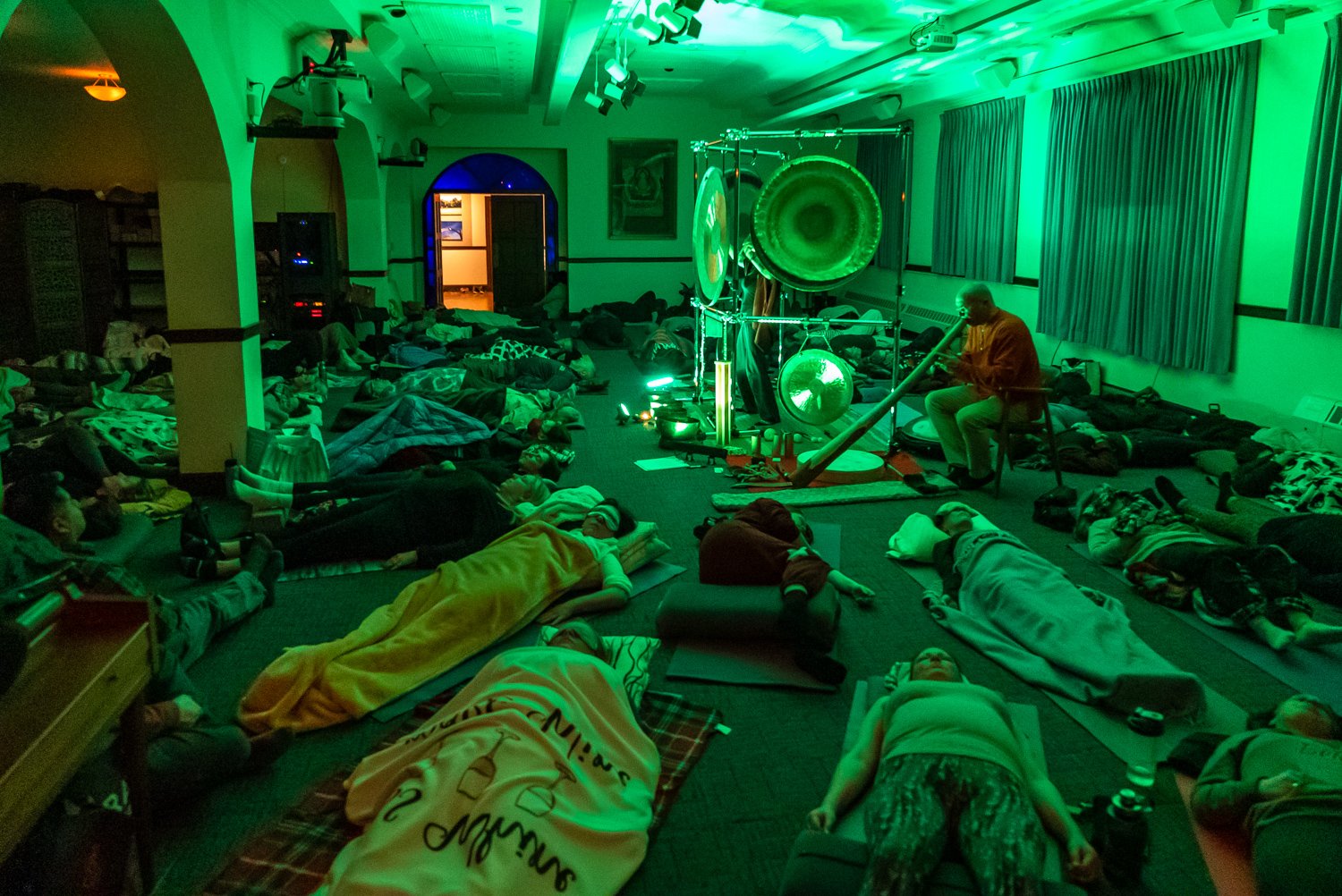The Harmonious Connection: Sound Therapy and the Vagus Nerve's Influence on Relaxation
Sound has been an essential part of human culture and healing for millennia. From the rhythmic beats of tribal drums to the soothing melodies of classical music, sound has a profound impact on our emotions, well-being, and even our physiology.
One remarkable aspect of this influence is the connection between sound and the vagus nerve, a crucial component of our autonomic nervous system responsible for regulating many bodily functions, including the relaxation response. In this entry, we will explore the impactful influence of sound on the vagus nerve and how it, in turn, affects the entire nervous system, particularly in triggering the relaxation response. If you want to see how sound affects matter, visit our Cymatics page, featuring its history along with some incredible videos.
The Vagus Nerve: A Key Player in the Nervous System
The vagus nerve, also known as the “vagal nerves” or the "wandering nerve" due to its extensive distribution throughout the body, is the longest cranial nerve. It plays a pivotal role in regulating the autonomic nervous system, which controls involuntary bodily functions such as heart rate, digestion, and respiratory rate. The vagus nerve is a bi-directional communication channel, conveying signals between the brain and various organs, muscles, and glands.
It is the biggest nerve in the body that connects to all the major organs. It starts in the brainstem, is one of the ten cranial nerves, and comes down by the ear, where it connects through a little branch called tympanic branch, to the tympanic membrane. This membrane is also known as the eardrum, which separates the outer ear from the inner ear. When sound waves reach the tympanic membrane, they cause it to vibrate. The vibrations are then transferred to the tiny bones in the middle ear. That means that every single sound that we experience through our ears sends information to the vagus nerve which then goes to regulate all your organs in the way of electromagnetic frequencies. Sound is already by design evolutionarily embedded into our nervous system.
So when we now return to the autonomic nervous system, we need to remember that the autonomic nervous system has two main sub-branches: the sympathetic and parasympathetic, with the vagus nerve being the main nerve of the parasympathetic nervous system (this system controls specific involuntary body functions such as digestion, heart rate, immune system etc.)
When activated, the vagus nerve helps to reduce heart rate, lower blood pressure, and enhance digestion, all of which contribute to a sense of calm and relaxation. The heart beats slightly faster as we inhale and slower as we exhale, termed, Respiratory Sinus Arrhythmia (RSA), which is a measure of vagal tone.
These two aspects of the autonomic nervous system can be thought of as a sympathetic accelerator and a parasympathetic break, providing bi-directional neural communication between our organs and brainstem. Several nerve tracts in the brain can send sympathetic signals to stimulate a faster heartbeat but only the vagus nerve sends a slowing signal, achieved during exhalation.
Therefore, one of the vagus nerve's most noteworthy functions is its role in the parasympathetic nervous system, which is responsible for promoting relaxation and restoring the body to a state of balance after stress or activity.
The Sound and Vagus Nerve Connection
Sound bathing journeys, known to ancient cultures for millennia, and nowadays being part of the holistic healing modalities, utilize sound vibrations to promote physical and emotional well-being. They have increasingly gained recognition for their positive impact on the vagus nerve. This noteworthy connection is multifaceted and operates through various auditory stimuli:
Auricular Vagal Stimulation:
The auditory nerve that carries sound signals from the ears to the brain receives close crosstalk from the auricular branch of the vagus nerve (the branch of the vagus nerve that supplies sensory innervation to the skin of the ear canal, tragus and auricle). This provides a powerful, yet simple way to provide vagal stimulation, via the tragus of the ears. Stimulating the vagus nerve by singing, or by applying ELF (extra low frequencies) to the tragus, restores cytokine balance, leading to a reduction in chronic inflammation.
This form of therapy also slows the rate at which we age. Among many other health benefits, it furthermore boosts sexual function, while the other mechanism involved in sexual arousal is Nitric Oxide production, which can also be created by sound and music.
Frequency and Resonance:
Different sounds and frequencies can stimulate the vagus nerve in unique ways. Low-frequency sounds, such as the gentle hum of gongs, Himalayan singing bowls or the deep tones of a didgeridoo, can resonate with the body and stimulate the vagus nerve, inducing a deep sense of relaxation. Many researchers have found that the range of 5 to about 20 hertz is the optimal range for vagus nerve stimulation.
Rhythmic Patterns:
Rhythmic sounds, like drumming or chanting, have been shown to synchronize with the vagus nerve's natural rhythms. This synchronization can help regulate heart rate and promote a sense of calm and balance. Shamans have been using low frequency sounds and rhythmic drumbeats to prompt deepened states of relaxation and altered degrees of consciousness.
Binaural Beats:
Binaural beats, created by playing two slightly different frequencies in each ear, can influence brainwave patterns. Some studies suggest that specific binaural beat frequencies can stimulate the vagus nerve and facilitate relaxation.
Mindfulness, Intention and Meditation:
Sound therapy often incorporates mindfulness, intention and/or meditation, while encouraging individuals to focus their attention on the sounds and their healing properties. When working with the mind in meditation, consider a sacred sound tool, very simple and very powerful, namely chanting the ancient sound of ‘OM’ (Aum). OM is said to contain every sound in the universe within it. Research now shows that when a person chants OM, it creates limbic deactivation. By deactivating the limbic system, a person moves into a state of peacefulness. fMRI studies show that when a group chanted S, nothing happened when they looked at the brain. But when the group chanted OM, the areas associated with peacefulness lit up in the brain. Science is now quantifying what has been known for thousands of years.
When working with the mind in meditation, consider a sacred sound tool, very simple and very powerful, namely chanting the ancient sound of ‘OM’ (Aum). OM is said to contain every sound in the universe within it. Research now shows that when a person chants OM, it creates limbic deactivation. By deactivating the limbic system, a person moves into a state of peacefulness. fMRI studies show that when a group chanted S, nothing happened when they looked at the brain. But when the group chanted OM, the areas associated with peacefulness lit up in the brain. Science is now quantifying what has been known for thousands of years.
This mindful awareness can activate or support the vagus nerve's relaxation response.
The Relaxation Response, Chronic Stress and Sound Therapy
The sympathetic nervous system mentioned earlier, is a network of nerves that helps to activate the body’s ‘fight-or-flight’ response. This system's activity increases when a person is stressed, in danger or physically active. Suffice it to say that the world we live in today, and the chronic stressors we are subjected to, prompt a much prolonged ‘fight-or-flight’ response.
In contrast, when the vagus nerve is activated through sound therapy, it triggers what is known as the relaxation response. This physiological and psychological state counteracts the ‘fight-or-flight’ response, promoting a sense of tranquility, reduced stress, and improved overall well-being.
The relaxation response can have profound effects on the body, including:
Reduced Stress Hormones: Activation of the vagus nerve leads to a decrease in stress hormones such as cortisol, which helps lower anxiety levels and improve mood. It can also support a homeostatic response.
Enhanced Immune Function: Chronic stress weakens the immune system, whereas the relaxation response can bolster immunity by reducing inflammation and supporting the body's natural defenses.
Improved Digestion: A relaxed state encourages better digestion and nutrient absorption, promoting overall gastrointestinal health (a.k.a. ‘rest and digest’). A well-toned vagal nerve has also been shown to reduce sugar cravings.
Pain Management: The relaxation response can also diminish the perception of pain, making it a valuable tool in pain management. The medical profession has been increasingly taking note of this, and specific sounds and music are being used to manage or mitigate pain.
To summarize:
Sound therapy's ability to influence the vagus nerve and trigger the relaxation response demonstrates the profound impact of sound on our nervous system and overall well-being. By harnessing the therapeutic power of sound, individuals can tap into their body's natural mechanisms for relaxation and healing, fostering a state of balance and tranquility in an increasingly stressful world. As we continue to explore the therapeutic potential of sound, we unlock new avenues for promoting mental, emotional, and physical health.
We encourage you to explore this fascinating subject further and invite you to experience a skillfully applied sound therapy event in person or online.
Please note that for the sake of clarity, we have used Sound Therapy synonymous with equally meaningful terms that are being frequently used, such as Sound Bath, Sound Bathing, Sound Bath Journeys, Sound Bath Meditations, Sound Journeys, Gong Baths and others.
It is also noteworthy to mention that in our opinion and experience, sounds that may not be perceived as ‘harmonious’ or ‘pleasant’ to one’s auditory perception, can actually have adverse effects on the body and overall sense of well-being, if exposure exceeds tolerable levels.
Research for this entry includes lectures by Dr. John Beaulieu, Barry Goldstein and John Stuart-Reid. We are grateful for your work in this field.

